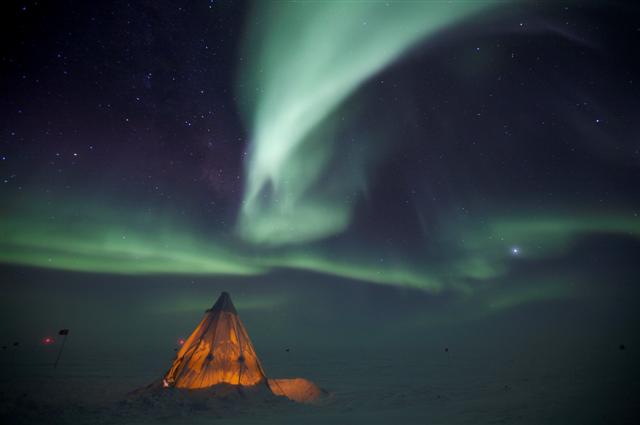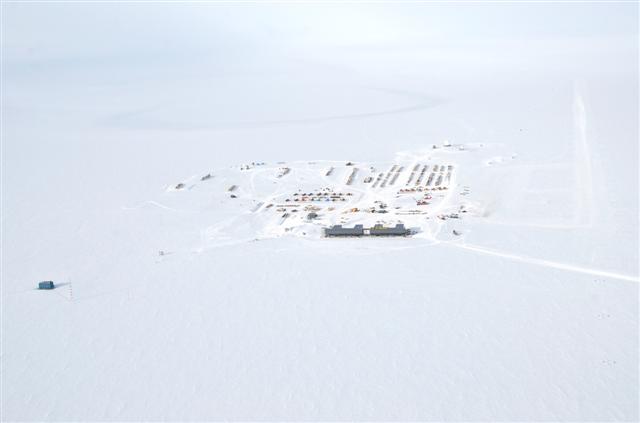Highs and lowsSouth Pole annual average temperature in 2009 ties 2002 for warmest year on recordPosted April 30, 2010
Updated July 25, 2014 [Editor's Note: Updated data showed that 2009 and 2002 were statistically the same temperature. Previously, we reported that 2009 had been one-tenth of a degree warmer.]
The average temperature at the South Pole was a bone-chilling minus 47.9 degrees Celsius (minus 54.2 Fahrenheit) in 2009. It tied with 2002 for the warmest year on record since 1957, when temperature records began at South Pole. The year 2009 was the second warmest on record for the planet in the last 130 years and the warmest for the southern hemisphere, according to an analysis of global surface temperatures by NASA The South Pole had gone two winters — 2008 and 2009 — without breaking the minus 100 degrees Fahrenheit barrier, according to Tim Markle, senior meteorologist at the South Pole Station The lowest temperature in 2008 was minus 99.9F/minus 73.3C and in 2009 was minus 98.0F/minus 72.2C. The latter also represents the warmest minimum temperature recorded for a calendar year, Markle said. Previously, the warmest minimum temperature was minus 99.0F/minus 72.8C in 1964. In 2007, the temperature plunged below minus 100F for only about a minute on Sept. 2, Markle added, meaning that the last three calendar years didn’t significantly reach minus 100F. April 2010 is a different story. On April 13, the station recorded temperatures below minus 100F for 22 minutes. “Again, not really all that long,” Markle wrote via e-mail. “However, it was certainly the coldest temperature since Sept. 2, 2007, and a long enough duration for one group of Polies to achieve membership status into the 300 Club.” The April 13 occurrence was the second earliest of minus 100F in South Pole history. The earliest occurrence of minus 100F happened on April 7 to 8, 1982. “From archived observations it appears that this cold snap occurred over a period of 24 to 30 hours with the temperature falling to minus 103.4F/minus 75.2C, the coldest temperature recorded in April,” Markle said. “This overlap into a two-day span is why I personally state that the occurrence on [April 13, 2010] was the second earliest and not the third.” The intense April cold was recorded elsewhere on the continent as well, according to Matthew Lazzara The AWS at Dome Fuji, the second highest point in Antarctica at 3,810 meters (about 12,500 feet), also recorded temperatures below minus 100F in April, Lazzara said. Two AWS systems about 100 kilometers from South Pole also got close to the mark, he added. “We’ve been looking at South Pole climate, and from 1957-2006, they were at or below minus 100F only five times in April. This is quite unusual,” noted Linda Keller, a researcher in the Department of Atmospheric and Oceanic Sciences However, except for the two-week cold snap in April, South Pole has been much warmer than normal in 2010, Markle reported. It is a “whopping” 5.6F/3.1C degrees above the climatological norms for January, February and March, he said. Do any of these trends at the South Pole mean anything in the bigger picture of climate change? “With regards to South Pole, we are currently working on a climatological analysis for South Pole, and we are still engaged with that,” Lazzara said by e-mail. “Once we do finish our analysis, we’ll know more.” NSF-funded research in this story: Matthew Lazzara, University of Wisconsin-Madison, Award Nos. 0636873 |



For USAP Participants |
For The Public |
For Researchers and EducatorsContact UsU.S. National Science FoundationOffice of Polar Programs Geosciences Directorate 2415 Eisenhower Avenue, Suite W7100 Alexandria, VA 22314 Sign up for the NSF Office of Polar Programs newsletter and events. Feedback Form |



